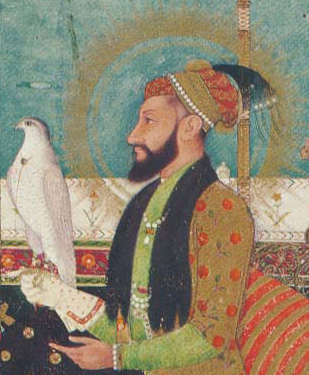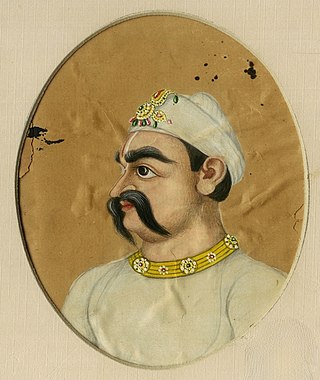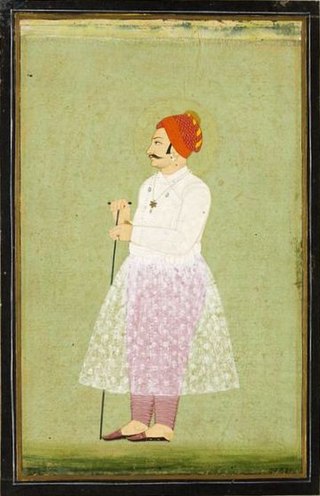Related Research Articles

Muhi al-Din Muhammad, commonly known by the title Aurangzeb, and also by his regnal name Alamgir I, was the sixth Mughal emperor, reigning from 1658 until his death in 1707. Under his reign, the Mughal Empire reached its greatest extent, with territory spanning nearly the entirety of the Indian subcontinent.
The Mansabdar was a military unit within the administrative system of the Mughal Empire introduced by Akbar later used in all over in early modern India. The word mansab is of Arabic origin meaning rank or position. The system determined the rank and status of a government official and military generals. Every civil and military officer was given a mansab, which determined their salaries & allowances. The term manasabadar means a person having a mansab. In the mansabdari system founded by Akbar, the mansabdars were military commanders, high civil and military officers, and provincial governors. Those mansabdars whose rank was one thousand or below were called Amir, while those above 1,000 were called Amir-al Kabir. Some great Amirs whose ranks were above 5,000 were also given the title of Amir-al Umara.

Maharaja Suraj Mal, simply known as Suraj Mal, was a Jat ruler of Bharatpur State in the present-day state of Rajasthan. Under him, Bharatpur State, a tributary of the House of Scindia, covered the present-day districts of Agra, Alwar, Aligarh, Bharatpur, Dholpur, Etawa, Hathras, Mainpuri, Meerut, Ghaziabad, Mathura, and Rohtak, Sonipat, Jhajjar, Nuh, Palwal, Faridabad, Kasganj, Mainpuri, Firozabad, Bulandshahr.

Gokula was a Hindu Zamindar of Tilpat region who led the Hindu Zamindars to a revolt against Mughal rule, during the reign of the Mughal Emperor Aurangzeb.
Raja Ram was the first leader, who organised a rebellion against Aurangzeb. He was the first chieftain Jat leader, who organised a rebellion against Aurangzeb. He was the chieftain of Sinsini. Before Rajaram the Jats were organised by different village heads dotted around Agra, Mathura and the Yamuna river. To avenge the death of Gokula, Rajaram destroyed Akbar's tomb and dragged Akbar's bones and burned them with the help of the Jat Zamindars of Braj. After his death, his brother Churaman and son Fateh Singh continued the struggle against Aurangzeb.

Churaman was a Jat chieftain of Sinsini, Rajasthan. He became leader of the Jats after Rajaram's death. Bahadur Shah I made him a mansabdar after he supported him against Muhammad Azam Shah in becoming the emperor. He was also made the faujdar of Mathura, and the imperial highway from Delhi to Agra was placed under his protection by the Mughal Emperor.

Mirza Muhammad Akbar was a Mughal prince and the fourth son of Emperor Aurangzeb and his chief consort Dilras Banu Begum. He went into exile in Safavid Persia after a failed rebellion against his father in the Deccan.

Maharaja Jawahar Singh was the ruler of the Bharatpur State. He succeeded to the throne when his father Maharaja Suraj Mal Ji died in 1763.

Muhammad Ismail, known by his title Zulfiqar Khan, was a leading noble and military general of the Mughal Empire. His father was Asad Khan, wazir to Mughal emperor Aurangzeb. During Aurangzeb's reign, Zulfiqar Khan led several military campaigns in pursuit of the emperor's ambitions in the Deccan and South India, notable of which is the Siege of Jinji. He held the post of mir bakhshi, appointed towards the later part of Aurangzeb's reign, and was made governor of the Deccan by emperor Bahadur Shah I. These positions helped make Zulfiqar Khan the most powerful noble in the empire by the early 1700s.

Mirza Raja Bishan Singh was the Kachwaha Rajput ruler of the Kingdom of Amber. He succeeded his grandfather Mirza Raja Ram Singh I since his father Kishan Singh died in the lifetime of his grandfather.He was also the subahdar of the province of Assam from the year 1687 to 1695 in the reigning times of Mughal Emperor Aurangzeb. He was succeeded by Sawai Jai Singh II.

Akbar's tomb is the mausoleum of the third and greatest Mughal emperor Akbar. The tomb was built in 1605–1613 by his son, Jahangir and is situated on 119 acres of grounds in Sikandra, a suburb of Agra, Uttar Pradesh, India. The buildings are constructed mainly from a deep red sandstone, enriched with features in white marble.

The Tomb of Mariam-uz-Zamani or Mariam's tomb is the mausoleum of Mariam-uz-Zamani, commonly known as Jodha Bai, the favorite wife of the Mughal Emperor Akbar. The tomb was built by her son Jahangir, in her memory between years 1623–1627 and is located in Sikandra, next to the Akbar's tomb, in the direction of Mathura. She stands as the only wife of Akbar buried closed to him.

Bharatpur State was an independent kingdom from 1722 to 1826 and a princely state under British suzerainty from 1826 to 1947. It was ruled by the Sinsinwar clan of the Hindu Jats. The state was founded by Maharaja Badan Singh in 1722. Suraj Mal played an important role in the development and expansion of the state. At the time of the reign of Suraj Mal (1755–1763), revenue of the state was 17,500,000 gold coins per annum.

Rahmat-un-Nissa, better known by her title Nawab Bai, was a secondary wife of the Mughal emperor Aurangzeb. She gave birth to Aurangzeb's first two sons, including Bahadur Shah I, who became Mughal emperor in 1707. Nawab Bai was unpopular at the Mughal court and lost her husband's favour quite early on in her life while the misconduct of her sons, Muhammad Sultan and Muhammad Muazzam, embittered her latter life. She died in 1691 in Delhi after long years of separation from her husband and children.

Muhammad Bidar Bakht was a Mughal prince. His father, Muhammad Azam Shah, briefly reigned as Mughal emperor in 1707. Bidar was noted for being a gallant, skilful and successful general and was regarded as the most able Mughal prince of his time. He was the favourite grandson of Emperor Aurangzeb.
Kandahari Begum was the first wife of the Mughal emperor Shah Jahan and the mother of his first child, Princess Parhez Banu Begum.

The battle of Kumher was fought among Jats, Marathas and Mughals.
The Battle of Fatehpur Sikri occurred near Fatehpur Sikri on 26 September 1721 between Mughal forces and those of the Jats. 10,000 Mughal forces were led by Nilkanth against 6,000 soldiers led by Muhkam Singh Sinsinwar of Thun and Shardul Singh of Pathena. Nilkanth was killed during the battle, ultimately a failed attempt by the Mughal to re-establish themselves.
The Battle of Tilpat was fought between Jats and Mughal Subahdars on 12 May 1669. Gokula jat burnt the city of Saidabad near Mathura which caused Mughal commander Abdul Nabi Khan to attack the village of Sūra. Abdul Nabi was wounded and killed. Aurangzeb sent Hassan Ali Khan to fight the rebels. Gokula Jat was captured alive in between the fight and immediately sent to Delhi.
References
- ↑ Kalikaranjan, Qanungo (1925). "History Of Jats". Internet Archive. Retrieved 28 October 2024.
- ↑ Manucci, Niccolao (2010). Mogul India (1653–1708): Or Storia Do Mogor. Low Price Publication.
- ↑ Ahmad, Aziz (1964). Studies in Islamic Culture in the Indian Environment. Oxford University Press. p. 95. OCLC 682954.
- ↑ Dwivedi, Girish Chandra (1989). The Jats: Their Role in the Mughal Empire. Arnold Publishers. p. 36. ISBN 978-81-7031-150-8.
- ↑ Richards, John F. (2001) [1993]. The Mughal Empire. The New Cambridge History of India: The Mughals and their Contemporaries. Vol. 5. Cambridge University Press. p. 251. ISBN 978-0-52-125119-8.
- 1 2 3 Dwivedi, Girish Chandra (1989). The Jats: Their Role in the Mughal Empire. Arnold Publishers. p. 37. ISBN 978-81-7031-150-8.
- 1 2 Asher, Catherine B. (2001) [1992]. Architecture of Mughal India. The New Cambridge History of India: The Mughals and their Contemporaries. Vol. 4 (1st ed.). Cambridge University Press. p. 108. ISBN 978-0-521-26728-1.
- ↑ Pande, Ram (1970). Bharatpur up to 1826: A Social and Political History of the Jats (1st ed.). Rama Publishing House. p. 7. OCLC 555482496.
- ↑ Pande, Ram (1970). Bharatpur up to 1826: A Social and Political History of the Jats (1st ed.). Rama Publishing House. p. 8. OCLC 555482496.